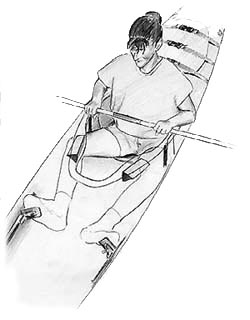
The Perfect Cockpit
Fitting Out Your BoatOne does not sit in a kayak; one wears a kayak - It's difficult to brace, make sweep turns, and/or to roll a kayak if your hips, knees, feet, and butt are not in solid contact with your boat. We sea kayakers may not require the glove-like boat fit favored by whitewater enthusiasts, but sliding around in our boats will noticeably hurt our paddling ability. In fact, one of the easiest things you can do to improve your paddling is to make your boat fit your body.

A kayak should not be so tightly padded that it is uncomfortable, but when you flex your ankles and push up with your knees a bit, you should be solidly "locked" into the cockpit. Knee Braces are the points where your knees touch the underside of the deck. You will pull the boat up from a leaned position or from a roll with your inside knee. Our boats with "keyhole" cockpits have a "bulge" in the coaming close to the front of the cockpit, which adds to the area available for knee bracing. You may want to pad this area with Minicel foam. You might also glue a small piece of half-round molding under the foam to keep your knee from accidentally slipping into the cockpit while it "pulls up on the deck." The best glue for foam is 3M #08001 Super Weatherstrip Adhesive, found in auto parts stores.


Hip braces prevent you from sliding off the seat. They need not be too snug, but they should limit sliding to an inch or so. Most wooden kayaks have wooden hip braces that are glued to the bottom of the boat and to the under side of the deck. Position these to accommodate your butt and pad them with 3/4" Minicel foam. If your boat is narrow or your build has, let us say, good initial stability, it might be better to leave out the wooden hip braces and simply pad out the kayak's side panels with a piece of 3" Minicel.